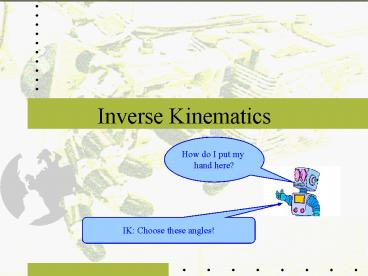Inverse Kinematics PowerPoint PPT Presentation
1 / 27
Title: Inverse Kinematics
1
Inverse Kinematics
How do I put my hand here?
IK Choose these angles!
2
Example Planar 3-link robot
- What is the reachable space? Take l1, l2 fixed
and vary ?3
3
The Workspace
- Workspace
- Workspace volume of space which can be reached
by the end effector - Dextrous workspace volume of space where the
end effector can be arbitrarily oriented - Reachable workspace volume of space which the
robot can reach in at least one orientation
4
Example (continued)
- What is the dextrous workspace in the example?
5
The IK Problem
- Kinematic Problem given joint angles and/or
displacement, compute location and orientation of
End Effector. - Inverse Kinematic Problem given location and
orientation of EE, find joint variables. - Why is IK hard?
- May have more than one solution or none at all
- Amounts to solving nonlinear trascendental
equations (can be hard)
6
Existence of Solutions
- A solution to the IKP exists if the target
belongs to the workspace - Workspace computation may be hard. In practice is
made easy by special design of the robot - The IKP may have more than one solution. How to
choose the appropriate one?
2 solutions!
7
Methods of Solutions
- A manipulator is solvable if the joint
variables can be determined by an algorithm. The
algorithm should find all possible solutions.
closed form solutions numerical solutions
- Solutions
We are interested in closed-form solutions 1.
Algebraic Methods 2. Geometric Methods
8
Method of Solution (cont.)
- Major result all systems with revolute and
prismatic joints having a total of six degrees of
freedom in a single series chain are solvable - In general, solution is numerical
- Robots with analytic solution several
intersecting joint axes and/or many ?i 0, 90o. - One major application (and driving force) of IK
animation.
9
Manipulator Subspace when nlt6
- If nlt6, then the workspace will be a portion of
an n dimensional subspace - To describe the WS compute direct kinematics,
and then vary joint variables - On the previous example, the WS has the form
10
Manipulator SS when nlt6 (cont)
- Usual goal for manipulator with n DoF use n
parameters to specify the goal - If 6 DoF are used, nlt6 will in general not
suffice - Possible compromise reach the goal as near as
possible to original goal - 1) Given the goal frame compute modified
goal in manipulator SS as near as possible
to - 2) Compute IK. A solution may still not be
possible if goal is not in the manipulator
workspace - For example, place tool frame origin at desired
location, then select a feasible orientation
11
Algebraic Solution
- The kinematics of the example seen before are
Assume goal point is specified by 3 numbers
12
Algebraic Solution (cont.)
- By comparison, we get the four equations
Summing the square of the last 2 equations
From here we get an expression for c2
13
Algebraic Solution (III)
- When does a solution exist?
- What is the physical meaning if no solution
exists? - Two solutions for ?2 are possible. Why?
- Using c12c1c2-s1s2 and s12 c1s2-c2s1
where k1l1l2c2 and k2l2s2. To solve these
eqs, set r? k12k22 and ?Atan2(k2,k1).
14
Algebraic Solution (IV)
Then k1r cos ? , k1r sin ? , and we can
write x/r cos ? cos ?1 - sin ? sin ?1 y/r cos
? sin ?1 sin ? cos ?1 or cos(??1) x/r,
sin(??1) y/r
15
Algebraic Solution (IV)
- Therefore
- ??1 Atan2(y/r,x/r) Atan2(y,x)
- and so
- ?1 Atan2(y,x) - Atan2(k2,k1)
- Finally, ?3 can be solved from
- ?1 ?2 ?3 ?
16
Geometric Solution
- IDEA Decompose spatial geometry into several
plane geometry problems
?2
Applying the law of cosines x2y2l12l22 ?
2l1l2cos(180??2)
17
Geometric Solution (II)
- Then
y
?
?
The LoC gives l22 x2y2l12 - 2l1? (x2y2) cos
? So that cos ? (x2y2l12 - l22 )/2l1?
(x2y2) We can solve for 0? ? ? 180, and then
?1???
x
18
Reduction to Polynomial
- Trascendental equations difficult to solve since
one variable ? usually appears as cos ? and sin?.
- Can reduce to polynomial in variable
- u tan ?/2
- by using
- cos ? (1-u2)/(1u2)
- sin ? 2u /(1u2)
- How? Use the fact that sin ? 2sin(?/2)cos
(?/2) and cos ? cos(?/2)2- sin(?/2)2
19
Pipers Solution 3 axis intersect
- Solution for manipulators with 6DOFs when three
consecutive axis intersect - We will consider the case of revolute joints and
last three axis intersect - Recall the transformation
20
Pipers Solution
- The vector P4ORG in the 3-frame has the form
And in the 3-frame
21
Pipers Solution (II)
- Repeating patiently
As mentioned before, for rotational joint does
not depend on ?1
22
- Replace the gis, using z g3 and work patiently
- If a10, r k3(?3). Solve for ?3
- If sin(?1)0, z k4(?3). Solve for ?3
- Otherwise, eliminate s2 and c2 above to get
23
Pipers Solution (IV)
- 1 and 2 above give a quadratic equation in
tan(?3/2) - 3 gives an equation of degree four
- Having solve ?3, can solve above for ?2 and ?1
- The remaining angles can be computed to give the
desired orientation.
24
Example PUMA560
- Want to solve
- TRICK Invert transformations to separate vbles
25
PUMA560 DK Solution
26
- Then
- Equating (2,4) element from two sides
- Equation can also be obtained from geometrical
arguments - Two possible solutions
27
- The size of the translation in 1 is independent
of ?1
- Geometrical meaning?
- Two possible solutions
- Write
- Repeat now a similar procedure

